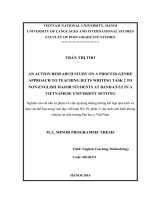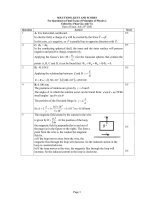Assessment task 2 team consultancy project written report lastly, recommendations are proposed for improvement in the workplace of generali the ability to empathize with each others
Bạn đang xem bản rút gọn của tài liệu. Xem và tải ngay bản đầy đủ của tài liệu tại đây (449.26 KB, 24 trang )
Assessment Task 2 - Team Consultancy
Project Written Report
Subject Code:
BUSM4699
Subject Name:
Cross-Cultural Management
Location & Campus
RMIT Vietnam, Hanoi Campus
Students:
Nguyen Huu Phuong Nhi - s3764731
Tran Quynh Ngoc - s3636101
Pham Hai Yen - s3776356
Nguyen Phuong Hong Yen - s3695645
Lecture:
Dr. Abel Alonso
Word Count:
3000
1
Executive Summary
Each person from various different cultures and backgrounds will have to interact
with each other more frequently in an increasingly globalized and growing economy.
Regardless of whether everybody will work and attempt together decently well,
diversification will in any case happen and cause furious struggles and clashes because of
an absence of comprehension of colleagues. Diverse reasoning or methods of working are
consistently a difficulty that each organization or business will have. The most clear
examples can be found in worldwide multinational organizations. Moreover, in an
increasingly technologically advanced world, virtual communication between countries is a
big step forward to help multinational groups communicate with each other quickly and
economically. However, global virtual teams (GVT) also hides many cross-cultural
challenges. To relieve this issue, individuals in particular and businesses in general, should
know about the fundamental drivers that have an immediate impact.
The objective of this report is to analyze several issues related to GVT of multinational
corporations with the use of academic theories and real cases of an international company in
Vietnam. The case of an multinational insurance company, Generali will be applied to evaluate their
practices in solving common cultural challenges. Besides, a supporting article about GVT
challenges perceived by millenials, is also reviewed. As a result, in such a broad community,
problems with communication and collaboration may often unintentionally offend each other.
Moreover, the interview conducted with Mr. Nguyen Tung Lam, regional director in Hanoi of
Generali, delivered a more in-depth perspective at the workplace from the viewpoint of a manager.
People communicate in their own unique manners, which may lead to misunderstandings when they
do not have the same level of understanding. In detail, difficulties of Generali in cross-cultural
virtual management could
2
be divided into 4 categories: leadership, communication, time issue and trust issue.
Lastly, recommendations are proposed for improvement in the workplace of
Generali. The ability to empathize with each other's cultural differences through training
and preparation demonstrates one's effort when attempting to collaborate with an
international partner. It is important for a large multicultural corporation to create its own
management structure in order to retain overall performance.
3
Table of contents
Executive Summary
Table of contents
1. Introduction
2. Overview of issues
2.1
2.2
2.3
2.4
Communication problems within multicultural teams or
Leadership in multicultural organizations or between su
Trust in multicultural groups or between subsidiaries w
Time issues within multicultural societies or between su
3. Case studies
3.1. Description of case study and research article
3.2. Analysis of the case study and article
4. Recommendations
4.1. Training
4.2. Time comfort zone and preparation for virtual meetings
Conclusion
Appendices
References
4
1. Introduction
Many businesses are looking to expand their operations internationally. By moving
to emerging markets, they will benefit from lower costs, as a result, contribute to the
economic development of countries. Generali, a big Italian insurance company is not
exceptional when it operates branches in Vietnam. However, doing business overseas
presents several challenges in terms of different human behaviors and a lack of knowledge,
especially when there is a significant difference in business concepts between Western and
Eastern. These difficulties become even more challenging in the virtual working context.
The theory of cross-cultural management was developed to help businesses submit, control,
and operate their business successfully on a global scale.
2. Overview of issues
The global economy is increasingly developing and expanding these days, with
trade value accounting for 60.4% of world GDP (World Bank n.d). Globalization is an
ongoing process, and understanding cultural differences has become a key factor for
multinationals to expand into emerging markets. Hence, as businesses evolve in the
international context and especially in the current covid outbreak then all companies have
to use virtual communication tools to support the work process, there is a question that top
managers and company insiders need to consider: how to communicate well between
cultures, to operate the business effectively, and how leaders need to give direction to find
the best solution. Therefore, there are four main problems that most businesses face in the
context of international business.
5
2.1 Communication problems within multicultural teams or across subsidiaries
Understanding a country's culture is about showing respect and ensuring effective
communication among members of an organization. Communication is the key to all problems that
need solving, expressing their thoughts and direct intercultural communication can sometimes lead
to confusion because of different ways of presenting messages. Especially during Covid pandemic,
it is even more difficult to transmit information or communicate in language when everyone has to
switch to virtual communication tools. There is research about low context communication terms
(LCC) and high contextual communication (HCC) and how they affect understanding and
interactions among people (Nam K.A 2015). When a group comprises multinational members,
communication conflicts between people from LCC culture and people from HCC culture will
easily lead to communication conflicts. It is more common in LCC cultures in individualist cultures
such as Western countries (Canada, Germany). They tend to express themselves through direct
verbal communication, speaking straight to the point. Verbal agreements are respected in HCC when
doing business, written contracts and signed agreements are essential while in LCC (William D
2015). This may cause conflict between enterprises when the business from LCC requires the
enterprise from HCC to write a signed contract may be perceived as disrespectful, and a lack of trust
can damage a relationship. While the culture of contextual communication is high as in some Asian
countries, the use of nonverbal communication involves paralinguistic signals (voice, pitch, volume)
and non-verbal signals (eye contact, smile, touch, silence). They often speak through a message that
they want others to ponder and understand. Currently, to achieve high performance in a
multinational environment, most companies adopt a Western working environment. This will help
employees be able to frankly express their individual opinions to make it easier to understand,
collaborate and save time.
6
2.2 Leadership in multicultural organizations or between subsidiaries
Leadership and culture have similar relationships. Different cultures will have
different images of a good leader. A survey of employees’ IBM from multiple locations
worldwide and four dimensions that different cultures were identified (Hofstede 2001).
While collectivistic culture is more team-oriented. Individualistic cultures tend to prefer
independent and different leaders (the GLOBE framework n.d). In the Certainty Avoidance
dimension, countries with a high degree of uncertainty avoidance often favor more
controlled regulators. Besides, the Power Distance also contributes to an excellent leader in
different cultures. Employees from cultures with low power gaps cultures prefer active and
participatory leadership. In contrast, those from cultures with a high power gap tend to
work better in a more directing style of leadership.
2.3 Trust in multicultural groups or between subsidiaries within an organisation
Every branch of Multinational Corporations faces challenges related to different cultures as
they resemble parent group operations in the local context (He R and Liu J, 2010). Administrative
personnel play a vital role in the failure or success of a Multinational Corporation, they must deal
with fundamental challenges like strategic and cultural differences. Nationalism has created friction
within a group that can cause trust between members or governance between the parent company
and its subsidiaries. Differences between cultures and languages can lead to misinformation,
distrust, as the story of Japanese and Americans working together has been likened to mixing
hamburgers with sushi (Hausmann R , Tyson D, Zahidi S, 2012). Because the Japanese and the
Americans have a long history before, and some Japanese still keep that hatred against their partner
and vice versa. Alternatively, the Vietnamese are still skeptical of China; requests for trust from the
Vietnamese towards their neighboring partners may be hard to accomplish. Moreover, due to
7
the centralized decision-making power at the headquarters, promotion opportunities for the
executive position of the host country nationals are limited. This creates communication
barriers, leading to misinformation and misunderstanding between host country nationals
and top managers of the headquarters. Hence, headquarters will have limited understanding
and interaction with the local staff to assess the performance of local ability for future
advancement (Ando N, Rhee D and Park N, 2007)
2.4 Time issues within multicultural societies or between subsidiaries
The virtual aspects of communication also have an impact on aspects of the
management tasks of MNCs. The most significant reported impacts include time zone
differences, response delays, and time limits for virtual communication (Kimble, 2001).
Around the world, we have different time zones, it can be challenging to get everyone in
the right group. It could be midnight in one part of the world, and it could be rush hour in
another. This is a problem because everyone needs to be on the same page and doing the
same thing. Team members must start work early and work very late to communicate with
each other, for instance, calling until 10pm or holding a three-way conference at 1 am
Swiss time (Oertig M & Buergi T, 2006). Besides, response delays and time limits for
virtual communication are also factors that create obstacles in an international environment
(See M 2018); in online meetings, they often bring up some new issues in meetings off the
agenda. It prolongs the meeting time and reduces the quality of the meeting. Furthermore,
when a subsidiary needs assistance from a qualified person, they cannot be present.
However, that day falls during the host countries' public holiday time, which leads to a
delay in reply while the subsidiaries need an immediate response.
8
3. Case studies
3.1. Description of case study and research article
3.1.1. Generali Group
Generali is a multinational insurance corporation based in Italy. The company
currently has 8 overseas headquarters and more than 60 branches in 50 countries. Vietnam
is one of the subsidiaries of Generali Group. The offices in Vietnam had about 2000
employees out of 72.000 employees worldwide. The Generali teams in Vietnam are mainly
responsible for sales, marketing and customer services for the local market. As R&D and
Operation management mainly take place at headquarters, branches in Vietnam receive
allocation targets from the head office in Milan or receive targets directly from Asia
Regional Office in Hong Kong. Regional meetings with the Asia Regional Office in Hong
Kong and its headquarters in Italy will take place monthly, or when the company
undertakes important projects. Meetings are usually in the form of an online conference. In
addition, other forms of virtual communication are applied such as emails, calls or
messages. Virtual communication is expected to help the company save costs and time for
travel, accommodation and human resources.
Figure 1. Workflow of Generali Vietnam
3.1.2. The article “When technological savviness overcomes cultural differences:
9
millennials in global virtual teams” (Velez-Calle et al. 2020)
We selected the research paper on the topic of virtual group challenges under the
perceived experience of millennials because this is one of the large demographic groups of
countries around the world (Deloitte 2020), and is expected to hold the senior positions of
employment in the next 5-10 years (Tilford 2018). The paper focuses on two major issues:
evidence to contradict previous international business literature which argues that cultural
differences are the main problem of GVT and how millennials work in GVT to deal with
the challenges of virtual teamwork and ensure effective team performance. The study
analysed 503 journals of undergraduate students from all over the world submitted to the
GEE competition in 2012.
3.2. Analysis of the case study and article
Our study analyzes the case of Generali and the findings in the article of Velez-Calle et al.
(2020), to uncover the key challenges companies face when working in multicultural virtual teams.
This study adopts the input-process-outcome (IPO) framework which was
adapted by Dulebohn and Hoch (2017) to align the context of the GVT 1. According to Hoch
& Kozlowski (2014), the IPO is the most widely used framework which is a tool to
categorize and incorporate theories on GVT.
3.2.1. Inputs
This study focuses on two input categories, which are team leadership and team
composition. Leadership plays an important role in virtual team performance. The leadership style
and management skills of team leaders significantly affect the working attitude and work efficiency
of the members (Serban-et-al.,2015). Unlike face-to-face team leadership, virtual team leaders
require a higher level of communication skills and cross-cultural
1 Appendix 1
10
understanding, since virtual communication is limited in space and time, as well as lacks non-verbal
signals (Tenzer & Pudelko 2016). In particular, the study of Hoch and Kozlowski (2014) shows the
importance of Cultural Intelligence (CQ) in virtual leadership. Leaders with a high level of CQ have
a positive effect on the team's performance, strengthen team cohesion and encourage engagement of
team members. Velez-Calle et al. (2020) also agrees with the importance of leadership in virtual
teams. Leaders in the analyzed cases are said to be the “rescuers” for the whole team when facing a
crisis, and the one who provides the leading solution for the team's challenges. However, the virtual
team leaders at Generali, in general, have not paid attention to this aspect. When asked in the
interview what strategies the company has in place to improve the understanding of diverse cultures
of managers, it seemed to be a new concept to the interviewee. There was a lack of proper -training
on how managers can solve problems related to multinational virtual teams.
The second input is team composition. At Generali, the most visible difference on the
surface of diversity is language differences. English is used as the common language for the three
countries to communicate with each other. However, because this is the second language of all three
countries, virtual team members have encountered many difficulties in expressing and
understanding the message. The barriers in verbal communication can be overcome more or less by
non-verbal communication (DiStefano & Maznevski 2000). For example, when you are unable to
express your ideas with words, gestures and facial expressions can assist in conveying your ideas.
However, when teams work virtually together, communicating from long distances through the
middle technology platform limits non-verbal communication (Jimenez et al.2017). This limitation
also makes it difficult to build close relationships between colleagues in different countries, which
also limits the level of trust and team cohesion of multicultural teams (Ford, Piccolo & Ford 2017).
The next component of team composition is the level of KSAs (knowledge, skills, and abilities) of
11
members. In the case of Generali, the level of CQ once again needs emphasis. For a multinational
company, understanding and adaptability to diverse cultures are the minimum requirements for
employees. One of the important elements in cross-cultural communication is the cultural context,
including low context and high context (Hall 1959). High context cultures like Vietnam emphasize
implicit messages that cannot be expressed in words. In
contrast, low-context cultures such as Italy emphasize direct verbal communication 2.
According to the interview, when working virtually, the lack of understanding of cultural
differences has made some Vietnamese employees feel uncomfortable when receiving too
frank opinions from the Italian manager. The limitation of the virtual working environment
further hinders mutual understanding.
3.2.2 Moderators
This study focuses on virtuality as the main moderator in the case of the Generali company.
Virtuality factor is a broad concept, which includes geographical dispersion, spatial distance,
temporal differences and configurational differences (Dulebohn & Hoch 2017). The time difference
is a key challenge that is associated with other cross-cultural difficulties in Generali. In the article
by Velez-Calle et-al. (2020), time difference is a frequently mentioned issue in students' journals.
However, the authors argued that the time difference problem does not belong to the concepts of
cross-culture issues, including values, beliefs and social systems (Hofstede 1991). The article also
cites one of the student journals in the study, where the time issue is mentioned as a solvable
problem and less significant than the other challenges. However, according to Dulebohn -and-Hoch(2017), temporal difference is one of the factors that affects the inputs and outputs of teamwork,
because it changes and connects relationships within the framework. This is true in the case of
Generali, where the time management problem, although not a culture issue, indirectly affects crossculture challenges. Firstly, the
2 Appendix 2
12
time zone in Italy is 5 hours behind Vietnam, so the ideal time for the two countries to
work together is 9am - 12pm in Italy, equivalent to 2pm - 5pm in Vietnam. However, 3
hours of collaboration is not enough time for the two teams to express the problem they are
facing through virtual meetings. As analyzed earlier, since both countries are non-native
English speakers, it usually takes a longer amount of time for the sender of the message to
express their ideas and to fully understand the opinion of the others. Besides, the next time
management problem is the different holidays of Vietnam and Italy. If a team reports a
problem to another country during these days, they have to wait until the end of the holiday
to get an answer. In this case, although the time difference is not a cultural concept, it does
add to the challenges associated with communication difficulties. Moreover, this degree of
influence increases as task interdependence and task complexity increases.
4. Recommendations
People can not be forced to be changed, therefore, it is recommended to encourage
people to adapt and be aware of culture intelligence through training leaders and
employees, time comfort zone arrangement and virtual meetings preparation.
4.1. Training
4.1.1. Building and training team leaders
Ank and Inkpen (2008) stated that a manager’s knowledge of norms, practices and
conventions in different cultures are gained from education and experiences. Therefore, extra
training is needed to ensure a qualified manager could handle challenges within the team as well as
show the employees how much the organisation cares about solving these issues. Training in goal
setting, role clarification, conflict resolution and ability to build trust of team members has to be
delivered to the leaders (Ford, Ronald & Loren 2017, p. 29). To build trust, the leader is expected to
build both credibility and reliability by never failing to
13
complete any promise or task, keeping open-access for all team members during the
projects and maintaining continuous and predictable communication schedules with each
member of the team (Brady & Prentice 2019, p.26). Leaders are required to explain
challenges and the scope of the work, time frame and limitation of the budget hence, at the
very first stage, the right people are chosen for the right position. Therefore, employees
will nurture themselves to adapt to new cultures. The responsibility of defining task goals
and role requirements for mission accomplishment to each member (Hunsaker &
Hunsaker, 2008) requires the leader to clearly explain the task, provide specific
performance feedback to the team, set and monitor deadlines, and hold members both
individually and collectively (Ford, Ronald & Loren 2017, p. 32).
4.1.2. Training employees
Training is the key solution for GVT issues therefore, not only the leaders need to
be trained but also the whole team members.
a, Innovation work behaviour
Employee innovative behaviour which is presented through the ability to develop, adopt and
implement new ideas is essential for business success (Yuan & Woodman 2010, p. 323). Employees
imply it by rethinking and changing the underlying principles of the company to maximise the
performance. There are several recommendations to encourage employees’ creativity and enhance
their innovation which include being open-minded with team diversity where employees are forced
themselves to be flexible and tolerant of differences; participating in projects with a sense of having
to work hard on challenging and important tasks; encouraging employees to take responsibilities
and take control over their works. The positive impacts of innovation are proved in many scholars
as the employees would enjoy more work satisfaction, achieve higher performance and productivity,
develop personal growth, improve relationships among workplaces (West and Anderson, 1996).
14
b, Multiculturalism
On the other hand, multiculturalism is suggested to help employees to balance their
different cultural identities and develop appropriate communication styles within the
workplace (Korzilius, Bücker & Beerlage 2017, p. 15). Multicultural people or expatriates
are people crossing national borders to work and live in bicultural or multicultural
environments.. Brannen and Thomas (2010, p. 13) suggested that the business should build
environments where bicultural people can thrive. Business could provide language courses
to those not speaking predominant languages in team or provide translators during
discussions, celebrating or at least showing the awareness of the national celebrations at the
virtual team location, operate cultural activities such as making quizzes about cultures,
having time to chat, go out for a meal or organize seminars to specific regions to give
chances to everyone to explore different cultures.
c, Cultural Intelligence
Cultural intelligence (CQ) refers to the ability to adapt to other cultures quickly and be able
to view businesses through various cultural lenses (Thomas et al, 2015). Elenkov and Manev (2009)
and Korzilius, Bücker & Beerlage (2017) suggested that expatriates need CQ to integrate
knowledge from different cultures into their innovative behavior. (Figure 2)
Figure 2: Conceptual model (Korzilius, Bücker & Beerlage 2017, p. 16)
CQ is a multifaceted construct which includes the heart( CQ motivation: the drive to put the
effort in adapting to new culture), the head (CQ knowledge: the knowledge of the norms, practices
and conventions acquired from education and experiences), the head (CQ
15
strategy: the process to generate cultural knowledge), the body (CQ behaviour: the
capacity to exhibit actions).
Figure 3: Cultural Intelligence construct (Alonso 2021)
Four components of CQ are hand and hand with each other and form a strong
construct. Applied to this construct, the CQ training process which is achieved through
team leaders and employees training also goes through step by step and hence, it is
expected to be successful. The training will create the motivation for employees to commit
to the company and then acquire the new culture through supportive activities, HR
procedures and company strategies. It will lead to adaptability, from that, team cohesion
and trust is built and as the result, the key problem of cultural management is resolved.
4.2. Time comfort zone and preparation for virtual meetings
In central European Times (CET), the time from 14:00 to 15:00 is considered as the Golden
Hour in many multicultural companies. However, it will fall in the evening for the people working
in the Asia-pacific region. (Brady and Garry 2019, p.31). Therefore, employees need to arrange the
time to be the most efficient by asking everyone to coordinate the time and even accept the schedule
is likely to be inconvenient for somebody. It is
16
suggested that the leaders should choose varying time for virtual meeting times which
shows the same favour and respect from leaders to different people from numerous time
zones (Chhay and Kleiner 2013).
A probable planning is also incredibly important in virtual team meetings. Virtual
meetings need to be held regularly or at least once a year and are well prepared in advance
and notified by everyone. A well-prepared planning requires a clear agenda, a
straightforward facilitation structure that includes time for individual contribution, small
group work, presentation, integration and co-creation as a team (Brady and Garry 2019,
p.92). This will increase the productivity of the meetings, reduce the wasting time and
hence, minimise the gap of misunderstanding and inefficiency.
Conclusion
To conclude, under the control of the headquarters in Italy, Generali Vietnam
suffered several problems which are communication, leadership, trust and time differences.
In order to solve these issues, there are numerous recommendations for the company to
overcome and training is the key solution. Generali should improve their inward
correspondence following suggested solutions as recommended above. With legitimate
application and adaptation, Generali business will be more sustainable and beneficial.
17
Appendices
Appendix 1. The IPO framework of virtual team, reproduced from Dulebohn and Hoch
(2017)
18
Appendix 2. Meyer's CultureMap of Italy and Vietnam, adapted from Meyer, E 2021
Key interview questions and answers with Regional Director of Generali Hanoi Office We
would like to understand more about your company's cross-cultural context.
➔ We have expatriates as managers, or seeders in each branch. However, there is not
too much of a problem working with them, though. In general, Italians are quite
sociable, cheerful and have many similarities with the Vietnamese lifestyle. The
most prominent issue recently is probably related to online team meetings and
virtual communication.
How does your team conduct virtual meetings with managers in Italy?
➔ Skype for business is the platform our company often uses.
➔ There is a 5 hour difference between the two countries. So the most ideal time to
work together is afternoon in Vietnam, which corresponds to morning in Italy. We
had to make full use of the 3 overlapping hours to solve the problems. However,
that amount of time was quite short for both sides to fully express the issues.
➔ Some Vietnamese employees have poor English comprehension skills, this often
takes more time in the discussion to explain the ideas to employees. And
conversely, it also takes more time for them to fully express their opinions.
19
In your opinion, what are the key problems that you can see in virtual meetings?
➔ There are usually some new issues (which are outside of the agenda) raised during
the meeting without prior notice. It prolongs the time and reduces the quality of
meetings, because employees do not prepare in advance and they have to take time
to think and solve problems from the start. Once, we spent more than an hour just
thinking about what merchandise to give a customer.
➔ The other thing I can see is the differences in the way people think. Employees here
sometimes feel uncomfortable when receiving negative feedback from Italian leaders,
especially people in customer service departments, they are quite sensitive.
What strategies does the company have in place to improve the understanding of diverse
cultures as well as to manage employees from different cultures?
➔ This is not an issue that is often mentioned in our discussions and team leader
training sessions.
20
References
● Ando N, Rhee D and Park N, 2007, ‘Parents country nationals or local nationals
for executive positions in foreign affiliates: An empirical study of Japanese
affiliates in Korea’. Asia Pacific J Manage 25, pp 113-134
● Ang, S. and Inkpen, A.C 2008, “Cultural intelligence and offshore outsourcing
success: a framework of firm-level intercultural capability”, Journal compilation,
Vol. 39, No. 3, pp. 337-358.
● Baliga R and Jaeger M 1984, ‘Multinational corporations: Control systems and
delegation issues, Journal of International Business Studies, pp 25-40.
● Brady, J and Garry, P 2019, “Leadership through a Screen : a Definitive Guide to
Leading a Remote, Virtual Team” , Business Expert Press, New York.
● Brannen, MY and Thomas, DC 2010, “Bicultural individuals in organizations:
Implications and opportunity”, International Journal of Cross-Cultural
Management, vol.10, no.1, p. 5–16.
● Cagiltay K, Bichelmeyer B, Goknur K 2015, “Working with multicultural
virtual teams: critical factors or facilitation, satisfaction and success.”, Smart
Learning Environment, Vol. 2, Iss. 1, June, viewed 10 May 2021,
< />● Chhay, RV, and Kleiner, BH 2013, “Effective Communication in Virtual Teams'',
Industrial Management, Vol.55, no. 4, viewed 15 May 2021,
< />● Deloitte 2020, “The Deloitte Global Millennial Survey 2020”, Deloitte, n.d,
viewed 13 May 2021, < />● DiStefano J, Maznevski M 2000, “Creating values with diverse teams in global
management.”, Organizational Dynamics, Sep, Vol. 29 Iss. 1, pp 45-63, viewed
10 May 2021, < />● Dubina, IN and Elias GC 2016, “Creativity, Innovation, and Entrepreneurship
Across Cultures: Theory and Practices”, Springer New York, New York.
● Dublehohn J, Hoch J 2017, “Virtual teams in organizations.”, Human Resource
Management Review, Vol. 27, Iss. 4, December, viewed 13 May 2021, < />● Elenkov, D.S., and Manev, I.M 2009, “Senior expatriate leadership’s effects on
innovation and the role of cultural intelligence”, Journal of World Business,
vol.44, no.4, p.357–369.
● Ford R, Piccolo R, Ford L 2017, “Strategies for building effective virtual team: Trust
21
is key.”, Jan Feb, Vol. 60 Iss. 1, pp 25-34, viewed 10 May 2021, < />
● Ford, RC, Ronald FP and Loren RF 2017, “Strategies for Building Effective
Virtual Teams: Trust Is Key.”, Business horizons, vol. 60, no.1, p.25–34
● Goolaup S and Ismayilov T 2011, ‘The influence of power distance on
leadership behaviours and styles’, Umea School of Business.
● Hall E 1959, “The silent language.”, viewed 10 May 2021,
< />docid=alma9912091860001341&context=L&vid=61RMIT_INST:RMITU&lang=en
&search_scope=EverythingNOTresearch&adaptor=Local%20Search
%20Engine&isFrbr=true&tab=AllNOTresearch&query=any,contains,The%20Silent
%20Language&sortby=date_d&facet=frbrgroupid,include,9000356980423371573&o
ffset=0>
● Hausmann R , Tyson D, Zahidi S, 2012, ‘The Global Gender Gap Report’,
World Economic, pp 8-9
● He R and Liu J, 2010, ‘Barriers of Cross cultural communication in multinational
firms’, Halmstad School of Business and Engineering, Research Paper, China.
● Hoch J, Kozlowski S 2014, “Leading virtual teams: Hierarchical leadership,
structural supports, and shared team leadership.”, Journal of Applied
Psychology, Vol. 99, Iss. 3, May, viewed 13 May 2021, < />● Hofstede G 1991, ‘Wired International Teams Experiments’ In Strategic
Decision Making by Multicultural Virtual Teams
● Hofstede, 2001, ‘Culture's Consequences: comparing values, behaviors,
institutions and organizations across nations.’, Sage, Thousand Oaks
● Hubert, K, Bücker, JLE and Beerlage, S 2017, “Multiculturalism and Innovative
Work Behavior: The Mediating Role of Cultural Intelligence.” International journal
of intercultural relations, vol.56, no. 1, p.13–24.
● Hunsaker, PL, and Johanna SH 2008, “Virtual Teams: a Leader’s Guide.”
Team performance management, vol.14.no.1/2, p.86–101.
● Ivanov P 2020, “Power Teams Beyond Borders: How to work remotely and
build powerful virtual teams.”, 2 December, viewed 10 May 2021,
< />● Jiang S 2014, ‘What Constitutes the Success or Failure of Multinational
Corporations MNCs in Foreign Markets? A Case Study of Chinese and American".
Doctor of Philosophy, International Studies, Old Dominion University.
● Jimenez A, Boehe D, Taras V, V. Caprar D 2017, “Working across boundaries: Current and
future perspectives on global virtual teams.”, Vol. 23 Iss. 4, pp 341-349, December, viewed
10 May 2021, < />casa_token=2OUT1ytmpHcAAAAA:FHkd7gnX84waCe9MCdWZ0UgouARan0UVk
22
1ZV_L0F4Sow1nO0uFsWZTU3vqO5HI9Rh-_cAAE>
● Kimble 2001, ‘Effective virtual teams through communities of practice’,
Management Science Research Paper, No 2001/09.
● Lepsinger R, DeRosa D 2010, “Virtual team success: A practical guide for
working and leading from a distance.”, 19 October, viewed 10 May 2021,
< />● Levasseur R 2012, “People Skills: Leading Virtual Teams - A Change Management
Perspective.”, Vol. 32 Iss. 2, 1 April, viewed 10 May 2021, < />● Meyer, E 2021, “The Culture Map”, Erin Meyer Website, viewed 20 April
2021 < />● Oertig M & Buergi T, 2006, ‘The challenges of managing cross and virtual
project team’, Team Performance Management, Vol.12 No.1/2 2006 pp 23-30.
● Scandura 2005, ‘A needs driven approach to expatriate adjustment and career
development: A multiple mentoring perspective., Journal of International
Business Studies, Vol 5, pp 519–538.
● Scott CPR, Wildman JL 2015, ‘Culture, Communication, and conflict: a review of
the global virtual team literature.’, Springer, New York, pp 13-32
● See M 2018, ‘18 International Collaboration: are the challenges worth the
benefits?’, Jamin Sci 98 (suppl-3)
● The GLOBE Project n.d, ‘The GLOBE Framework’, Principles of management,
n.d, viewed 13 May 2021,
< />● Tenzer H, Pudelko M 2016, “Media choice in multilingual virtual teams.”, Journal
of International Business Studies, May, Vol. 47 Iss. 4, viewed 10 May 2021,
< />accountid=13552&pq-origsite=primo>
● Thomas, D. C., Liao,Y., Aycan, Z., Cerdin, J.L., Pekerti, A.A., Ravlin, E.C.& Van
D.V F 2015, “Cultural intelligence: A theory-based, short form measure”, Journal
of International Business Studies, vol.46, no.9, p.1099-1118.
● Tilford C 2018, “The millennial moment - in charts.”, Financial Times, June
6, viewed 13 May 2021, < />● Velez-Calle A, Mariam M, Gonzalez-Perez M, Jimenez A, Eisenberg J, SantamariaAlvarez S 2020, “When technological savviness overcomes cultural differences:
millennials in global virtual teams.”, 22 May, viewed 13 May 2021, < />● West, MA and Anderson, N1996, “Innovation in top management teams”, Journal
of Applied Psychology, vol. 81, no.6, p.680–693.
● World Bank n.d, ‘Trade (% of GDP)’, World Bank, n.d, viewed 13 May 2021,
23
< />end=2019&start=1960&view=>
● Yuan, F and Woodman, R 2010, “Innovative behavior in the workplace: The role
of performance and image outcome expectations”, Academy of Management
Journal, Vol. 53, no.2, p. 323–342.
24









